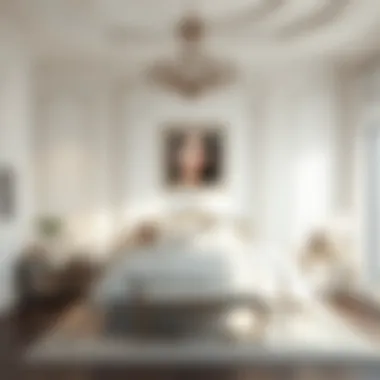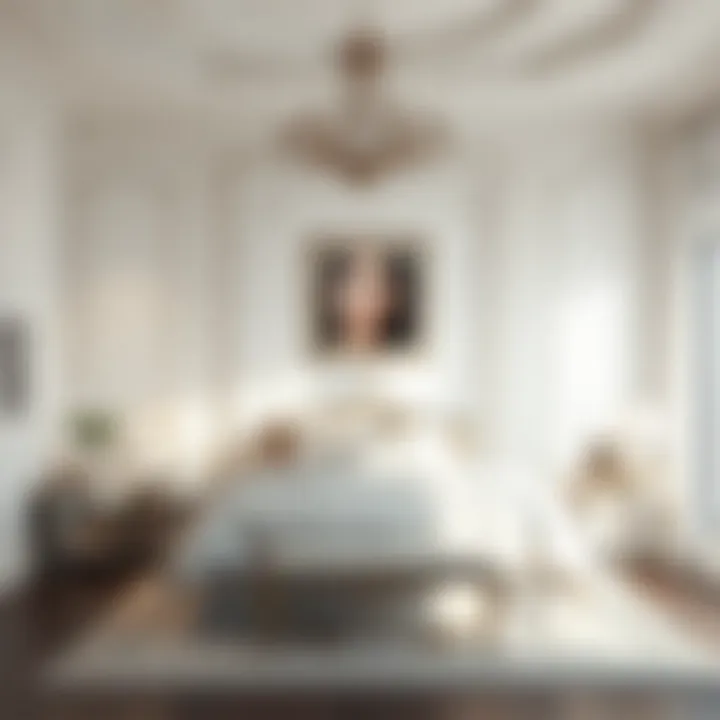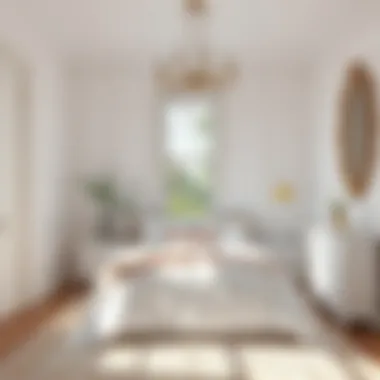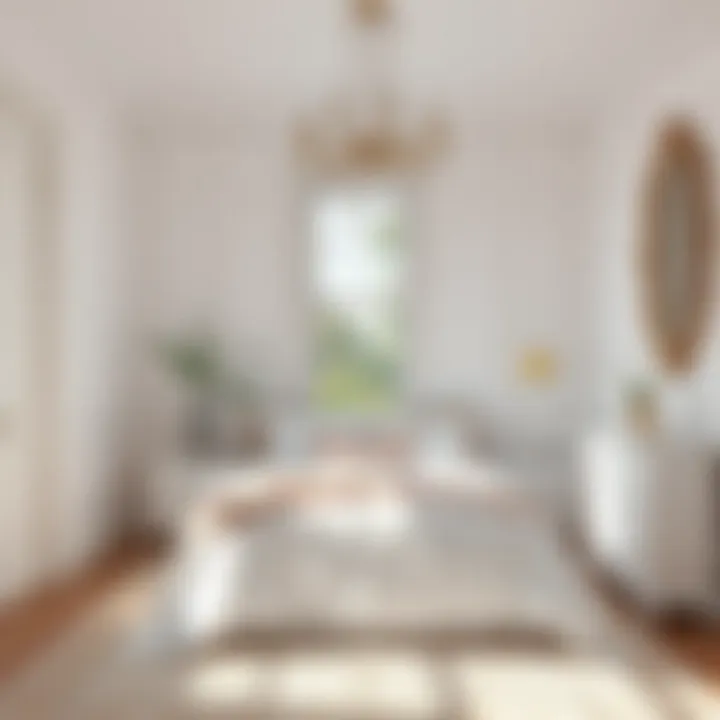Mastering the Elegance of White Bedroom Paint


Intro
Choosing the right color for your bedroom can be a daunting task. Among the myriad of colors available, white stands out for its timeless appeal and versatility. Many homeowners often ponder the implications of going with a blank canvas for their walls. While initially, it may seem like a simple choice, painting your bedroom white can lead to a transformative experience. From influencing the perception of space to shaping your overall mood, the decision carries weight.
This guide will take you through the journey of painting your bedroom white, offering insights on design inspirations, product recommendations, and practical aspects to consider. Whether you’re a seasoned decorator or a budding enthusiast, understanding the nuances of white paint can lead to a serene and sophisticated sanctuary that reflects your personality.
Design Inspirations
Trending Styles
In the world of interior design, white hues have taken center stage. From modern minimalism to classic elegance, white serves as a versatile backdrop that allows for creative expression. One popular trend is the fusion of white with natural elements. Think wooden furniture, earthy textiles, and greenery. The combination can evoke a sense of calm while adding depth to the space.
Another captivating style involves layering whites. Not just one shade, but an array of whites—warm, cool, pale, and bright—can create dimension and interest. Such an approach is particularly effective in a bedroom where soft, transitional light plays across the walls, enhancing the aesthetic.
Color Palettes
When selecting shades of white, consider how different tones interact with light and surrounding elements. Here are a few suggestions:
- Soft White: This shade leans towards warm hues and is perfect for creating cozy atmospheres. It pairs wonderfully with pastel colors or bright accents.
- Cool White: A crisp, bright option, ideal for modern and sleek designs. It complements darker furniture and bold decor, bringing a sense of freshness.
- Off-White: This versatile hue offers warmth without overwhelming brightness, making it ideal for pairing with earth tones.
- Antique White: With a slightly yellow tint, it adds a vintage charm to spaces and goes beautifully with ornate designs.
Combining shades of paint can elevate your design, introducing layers that enrich the overall appeal. Just keep in mind the direction of the light in your room when choosing your hues, as this can dramatically affect how the colors are perceived.
Product Recommendations
When embarking on your painting journey, the right tools can make all the difference. Here are some highly recommended products:
Bath Accessories
Investing in quality accessories can greatly benefit your painting project:
- High-quality paintbrushes: A good brush can mean the difference between a professional finish and one that looks a bit shaky.
- Paint rollers: Opt for rollers that fit the texture of your wall for a smooth application.
- Painter's tape: Essential for achieving clean lines, especially if you’re going to be putting white next to darker colors.
Bedroom Essentials
Apart from tools, consider these essentials for creating a harmonious space after painting:
- Soft bedding: Choose textiles that complement your white walls, such as soft grays or pastel colors. A quilt or light duvet can soften the look.
- Accessorizing with color: To avoid a sterile feel, add pops of color through pillows, wall art, or rugs. This provides contrast and character without overwhelming the serene vibe.
"Painting your bedroom white is not just about aesthetics; it's about creating an environment that nurtures mental wellness, relaxation, and clarity."
In summary, incorporating white into your bedroom may appear straightforward, yet the choices you make regarding shades, styles, and complementary elements can significantly impact the final result. Stay tuned as we explore further aspects of color psychology and maintenance tips in subsequent sections.
Prelims to Painting Bedrooms White
Transforming a bedroom through white paint is more than just putting a coat of color on the wall; it's a decision that carries weight in terms of aesthetics, mood, and even maintenance. In this section, we'll explore why selecting white for your bedroom is not merely a trend, but a strategic choice fostering a feeling of openness and harmony.
White, in its various shades, can serve as a backdrop to creativity and peace, enabling the space to evolve as your tastes change without needing complete overhauls. The significance of painting your bedroom white extends past visual appeal. It affects how light bounces within the room, creating illusions of space and warmth. While some may see white as plain or sterile, the right approach transforms it into a sanctuary. You can create a modern yet inviting atmosphere, allowing possibilities that may not be prevalent in darker hues.
When selecting a color for the bedroom, one must consider factors such as light availability, existing furniture, and the emotional atmosphere you wish to cultivate. This can be the differentiator between a room that feels cramped and one that breathes space. Moreover, white is versatile; it pairs well with practically every color, encouraging imaginative decor choices.
In summary, understanding the nuances of painting your bedroom with white is vital for anyone looking to enhance their living space. This article aims to provide insights on color theory, prepare you for painting, and help you select complementary elements that enhance the serenity and elegance of white walls.
"Choosing white is not just a matter of preference, but an invitation to create a landscape for your dreams and peace."
Whether you're a seasoned DIY enthusiast or a newcomer to home improvement, this guide will walk you through the essentials of embracing the art of white in your bedroom.
Understanding Color Theory
Color theory plays an invaluable role in interior design, especially when transforming a bedroom with white paint. It's not just about picking a color from the swatch on a wall. Color influences moods, spatial perceptions, and overall harmony. When one considers painting a bedroom white, it's essential first to comprehend how this choice interacts with the space and its inhabitants.
The Significance of Color in Spaces
Color breathes life into any room; it can uplift or flatten the ambiance. In a bedroom, where tranquility is key, selecting the right hue can vastly affect how one feels upon entering.
White, in various forms, has the unique ability to amplify natural light, creating an inviting glow that permeates throughout the space. A bedroom drenched in white can feel more spacious, airy, and uncluttered.
Here are some points about the significance of color in spaces:
- Psychological Impact: Different colors evoke distinct feelings. For instance, blue often calms, while yellows can energize.
- Spatial Awareness: Colors can make areas feel larger or smaller. Visually, white expands boundaries, enhancing the perception of a room.
- Design Cohesion: A well-chosen color scheme can harmonize various elements in the room, eliciting a sense of balance and design flow.
Ultimately, when thinking about the color palette for a bedroom, it is advisable to consider not only personal preferences but also the functionalities that specific colors provide.
White: A Clean Slate
Describing white as a clean slate isn't just about aesthetics; this notion encapsulates its transformative potential. White is not simply devoid of color. It can embody infinity and purity, creating a backdrop that resonates with serenity.


In a world filled with visual clutter, white walls invite simplicity and peace. The attribute of renewability associated with white suggests that it can adapt. As life changes, a white bedroom can gracefully evolve with new decor, bedding, or accessories without the necessity for frequent re-painting. This adaptability renders white an attractive option for many homeowners.
Consider the following aspects of white as a clean slate:
- Reflection of Light: White surfaces reflect light effectively, ensuring bright spaces without needing multiple light sources.
- Timelessness: White walls can withstand shifting design trends, never falling out of style.
- Foundation for Creativity: A white room invites creativity, allowing for bold accessories or art without clashing.
"White signifies a fresh start; it offers endless possibilities in decorating, making it a favorite for many design aficionados."
So, whether one seeks peace, creativity, or simply a more spacious environment, understanding the emotional and aesthetic significance of white in bedroom design is crucial. By recognizing its properties, one can make informed choices that enhance the overall living experience.
Exploring Shades of White
When considering the impact of paint colors in a bedroom, one must appreciate the diverse array of whites available. While white might be seen as a single hue at first glance, it actually encompasses a broad spectrum, ranging from warm tones that invoke a sense of coziness to cool whites that echo a more modern and airy aesthetic. Each variant influences the ambiance and perception of the space in unique ways, making the selection of the right shade crucial for achieving the desired atmosphere.
Warm Whites vs. Cool Whites
Warm whites, often infused with yellow or beige undertones, tend to create an inviting and comfortable environment. These shades, like Alabaster from Sherwin-Williams or Dove Wing from Benjamin Moore, can transform a stark room into a nurturing sanctuary. They lend themselves well to spaces where relaxation is key, such as a bedroom. The warmth in these shades can be particularly effective in northern climates, where cooler light can overwhelm living spaces.
Conversely, cool whites, such as Chantilly Lace or Super White, lean more toward blue or gray undertones, contributing a crisp and clean feel. They can lend an aura of spaciousness and clarity, perfect for modern, minimalist designs. Many homeowners opt for these cooler tones, especially in rooms lit by abundant natural light, as they can reflect and enhance that brightness while creating a seamless transition with other design elements.
"Choosing the right shade of white isn't just about preferences; it's about how the color interacts with light and space. A warm white can soften a room, while a cool white can elevate it to new heights."
Choosing the Right Shade for Your Bedroom
Selecting the right shade of white for your bedroom is a dance of personal taste and practical considerations. Here are some factors to bear in mind:
- Lighting: Assess how natural and artificial light interacts with the white. Observe how it looks at different times of the day. Morning light can expose the undertones more than evening light.
- Room Size: Larger bedrooms may benefit from cooler whites to maintain a crisp, airy feel. In contrast, smaller spaces might thrive on the intimate warmth of creamier whites.
- Existing Decor: Take into account the colors of your furnishings and decor. A cohesive color palette is vital to ensure all elements of the room harmonize effectively.
When in doubt, testing paint samples on your walls can reveal the true character of a shade as the light shifts. Remember, the right white can make all the difference between a room that simply exists and one that truly feels like home.
Preparing for Painting
Before you pick up that brush or roller, there's a critical phase in the process of painting your bedroom white that cannot be overlooked. Preparing for painting is more than just grabbing a can of paint and starting to slap it on the walls. It sets the stage for the entire project, influencing not only the final outcome but also the ease and efficiency with which the task gets done.
Proper preparation ensures that paint adheres well and produces a smooth, lasting finish. Skipping this step might lead to an unappealing look or, worse, a need for a complete redo. Think of it as laying a solid foundation for your work. Here are the specific elements you must consider:
- Cleaning the Walls: Dust and dirt can create a barrier between the paint and the wall. Use a mixture of water and mild detergent to clean the surfaces thoroughly. This ensures that the paint sticks well, providing longevity to your efforts.
- Repairing Imperfections: Dents, cracks, or holes can spoil the otherwise pristine white surface you aim to achieve. Use spackling compound to fill these imperfections. Don’t just coat over them, but smooth them out to blend seamlessly with the wall.
- Choosing the Right Time: Weather can affect drying time and paint application. Ideally, paint during a dry period when humidity levels are low to allow the paint to cure properly.
Essential Tools and Supplies
Now that you’ve decided you’re prepared, let’s talk about the tools and supplies you will need. Having the right items can save you a lot of headaches during the process. Here’s a list of essential tools:
- Paint Brushes and Rollers: For a clean application, invest in high-quality brushes for corners and a roller for large areas.
- Painter's Tape: This tape will help define clean lines and protect areas you don’t want to paint, such as baseboards and adjacent walls.
- Drop Cloths: Keep your floors safe with these. Spills are bound to happen, and you don’t want to mar your floors or carpets.
- Paint Tray: A paint tray makes life easier. It allows you to load your roller without making a mess.
- Ladder: If you’re painting ceilings or high walls, a sturdy ladder is essential for reach and safety.
- Sandpaper: This will be useful for smoothing out repaired areas, ensuring a flawless finish.
Surface Preparation Techniques
Once you’ve donned your cleaning gloves and gathered your supplies, it’s time to delve into the nitty-gritty of surface preparation. The techniques you employ here will pave the way for a professional-looking finish.
- Cleaning: Start by wiping down the walls. If you have mildew or mold, a solution of water and vinegar can tackle that nasty business. Ensure that surfaces are dry before proceeding.
- Sanding: Lightly sand the walls with fine-grit sandpaper to create a smooth surface. This is especially important if your walls have any gloss from previous paint jobs; dulling the finish will enhance adhesion.
- Priming: If you're painting over a dark color or if the wall has stains, consider a primer. It not only improves the color quality of the white paint but also reduces the number of coats needed, saving time and resources.
By taking these preparation steps, you're not just setting yourself up for a better finish; you're also ensuring that the paint job stands the test of time. Remember, a successful paint transformation hinges largely on how well you prepare your space. So, take your time with the planning, and the results will speak for themselves.
Painting Techniques
When it comes to transforming your bedroom through painting, the methods you choose can make all the difference. Painting techniques not only influence the final look but also determine the ease of application, durability, and overall experience of your project. Understanding these techniques is crucial to achieving a smooth, professional finish that enhances the serene atmosphere of your white-painted sanctuary.
Brush vs. Roller: Which to Choose?
Choosing between a brush and a roller can feel like a defining moment in your painting journey. Each tool brings its unique set of strengths and weaknesses to the table.
- Brush: Great for precision work and those tricky corners or edges. A high-quality brush allows for intricate detailing that can highlight texture differences in white paint. However, brushing may require more skill and can result in visible brush strokes if not done carefully.
- Roller: Ideal for covering large areas quickly, a roller gives you that uniform finish. It can be efficient, cutting down the time spent on tedious long strokes. However, it might be messy, especially for first-timers. Despite this, rollers are often preferred for walls as they can help achieve a smooth coat swiftly.
When deciding, consider the layout of your room and your comfort level with both tools. If you lean towards finesse, keep a brush handy for finishing details. If speed is your aim, a roller might be the way to go. Ultimately, most successful painters find a balance, using both tools strategically to harness the best of what each has to offer.
Applying Multiple Coats
One crucial aspect of painting that some might overlook is the importance of applying multiple coats. White paint, while often dazzling and bright, can sometimes require several coats for that flawless finish. Here’s why layering can be beneficial:
- Coverage: Depending on the type of paint you select, the first coat might not completely obliterate the previous color or provide full opacity. Layers can help ensure that soft hues and imperfections don’t peek through, preserving that crisp white ambiance.
- Depth: Multiple layers can add depth to the color, enhancing the overall aesthetic. The different refractions of light across these layers can create a subtle yet impressive effect in the presence of natural light.
- Durability: More coats also often mean greater durability. A thicker finish stands up better against wear and tear, essential for high-traffic areas in your home.
Tips for Coats:
- Allow the first coat to dry completely before applying the next. This ensures proper adherence and avoids peeling.
- Use a light touch when applying the second coat; it can help in achieving an even finish.
- Always inspect your work under different lighting conditions to spot areas that may need extra attention.
In summary, while it may take time, the effort put into applying multiple coats can truly make your white-painted bedroom a satisfying and serene space.


"A good paint job is often about patience; rushing can lead to regrets later. Take your time for a stunning finish."
By honing your painting techniques, you set the foundation for a beautifully transformed space that feels both inviting and tranquil.
The Role of Lighting
Lighting can make or break the vibe of any space, and this holds true for your bedroom painted in white. The interplay between color and light is essential, particularly with white walls, which can reflect and absorb natural and artificial light in ways that dramatically influence the overall atmosphere. Knowing how to harness both types of lighting is crucial for achieving the desired aesthetic and comfort in your bedroom.
Natural Light Considerations
Natural light is like a breath of fresh air in any room, and when it comes to white paint, it takes on an even more vital role. One significant aspect of using white is that it interacts uniquely with daylight, altering its tone throughout the day.
- Morning Glow: When the sun rises, its rays will warm the whites, giving them a cozy hue. This can create a soothing start to the day. It might be akin to sipping a warm cup of coffee first thing in the morning, a friendly embrace from your space.
- Midday Brightness: As the sun reaches its zenith, the light becomes a brilliant white, almost glaring. This can amplify the brightness in your bedroom, creating an energizing effect. To counteract potential harshness, you might consider softening elements such as sheer curtains or light-colored blinds, as they can filter the sunlight without dimming the space too much.
- Evening Ambiance: When the day winds down, that same bright white will take on cooler undertones as the sun sets. To maximize this comforting transformation, strategically placed mirrors can enhance light flow, while dim lighting can subdue the starkness of the white walls, creating a relaxed space for winding down.
In essence, embracing natural light not only elevates the aesthetics of your white-painted bedroom but also helps in setting the mood for varying moments throughout the day.
Artificial Lighting Effects on White Walls
When it comes to artificial lighting, the type and intensity play a significant role in how your white walls appear and feel. It’s important to consider not just the light fixtures but also the bulbs you select, as these elements shape the overall ambiance.
- Warm vs. Cool Bulbs: The color temperature measured in Kelvin (K) of your light bulbs will significantly affect how your white walls look. Warmer bulbs (around 2700K) will cast a soft, inviting glow, while cooler bulbs (5000K and above) bring a clinical and vibrant feel, which may not suit everyone’s taste. Be cautious, as too much cool light can contribute to a sterile atmosphere, which many folks might find off-putting.
- Layered Lighting: Using a mix of ambient, task, and accent lighting can create depth and nuance. For example, warm recessed lights can serve as ambient lighting, while table lamps with a softer shade can highlight specific areas such as reading nooks or art pieces, offering visual interest against that pristine white backdrop.
- Dimmer Switches: Incorporating dimmers allows for versatility in lighting throughout the day and night. You can easily adjust brightness levels to suit your mood or activity, maintaining a welcoming environment.
Embracing artificial lighting thoughtfully can transform your purely white walls into a living canvas that changes with the time of day and your needs.
Important Insight: The key to a well-lit white bedroom lies in achieving a balance between natural and artificial light. Too much of either can throw off the tranquility one seeks when creating a personal sanctuary.
In summary, understanding how both natural and artificial lights interact with your bedroom's white walls will not only enhance the room’s visual appeal but also affect its comfort and livability. Choose your lighting wisely, and the rest will fall into place.
Complementary Design Elements
When transforming your bedroom with white paint, it’s not just about the color on the walls. The surrounding design elements play a pivotal role in harmonizing the overall aesthetic. Framing your white walls with carefully selected furniture and decor can breathe life into the space, making it feel inviting and cohesive.
Choosing Furniture and Decor
In a room where white reigns supreme, the choice of furniture becomes crucial. Think of your pieces as the punctuation to your written narrative; they help convey the story that unfolds within four walls. From soft textures to striking forms, selecting the right furniture can enhance the elegance of white walls. Here are a few considerations:
- Color Contrast: Darker or more vibrant furniture stands out magnificently against a white backdrop. A deep navy blue sofa or an emerald green accent chair provides interest and depth. The contrast creates a visual dialogue, keeping the room from looking too plain.
- Material Matters: Wood, metal, and fabric interplay in unique ways with white paint. Light-colored wood pieces can complement the walls, while darker wood can add warmth. Metal elements, like brass or iron accents, can introduce a sophisticated sheen, providing a modern twist.
- Scale and Proportion: When choosing furniture, keep in mind the size of your room. Oversized furniture may overwhelm a small space, while a few elegant pieces can open it up and make it feel serene. Strive for balance; a striking bed frame deserves space around it to truly shine.
Through these subjective choices in furniture and decor, the starkness of white can transform into a sense of gracefulness and style, allowing for creativity within the bounds of simplicity.
Textiles: Adding Warmth to White
In a world where minimalism often means coldness, textiles can serve as a blanket of warmth, quite literally. Layering your bedroom with various textiles not only adds physical comfort but also an emotional one. This can turn what could be a stark white room into a cozy sanctuary.
Here’s how to achieve that welcoming feel:
- Bedding Choices: Opt for plush comforters or cozy quilts. Soft textures like cotton, wool, or linen can soften the overall appearance of white walls, creating a welcoming atmosphere. Choices in prints and patterns can also introduce a central theme or accent colors, allowing for playful expression without overwhelming the serenity of white.
- Curtains and Drapes: Light, airy drapes in muted shades can provide privacy while letting in natural light, creating a soft glow. Heavy drapes in darker tones might offer a dramatic contrast, providing not just aesthetic appeal but also thermal comfort.
- Throw Pillows and Rugs: A simple addition like a colorful rug or textured throw pillows can break the monotony of white. They infuse character and comfort, encouraging you to sink into the ambiance of your room.
Ultimately, textiles bridge the gap between warmth and whimsy, allowing homeowners and design enthusiasts to personalize a white-painted bedroom in a meaningful way.
"The key to creating a harmonious space is to embrace both contrast and unity between your white walls and surrounding elements."
In summary, thoughtful attention to furniture and textiles can make white walls resonate instead of merely reflecting. Your choices will invite elements of personality while maintaining the tranquil essence that white paint provides.
To learn more about color psychology and design elements, visit Wikipedia or check out resources from Britannica.
Maintenance of White Walls
Maintaining white walls in your bedroom isn’t just about keeping things pretty; it’s essential for ensuring the longevity and freshness of your living spaces. White paint can create a serene atmosphere, but it also comes with its unique challenges. Dust, fingerprints, and other imperfections can make even a newly painted wall look tired and worn out in no time. Understanding how to care for these surfaces is crucial for homeowners who want to keep their bedrooms looking bright and inviting.
Here are some specific elements and benefits of maintaining white walls:
- Visual Freshness: Regular upkeep helps retain the crispness of white paint, preventing it from looking dull or yellowed over time.
- Enhanced Atmosphere: A clean, well-maintained wall reflects light effectively, contributing to a brighter and more spacious feel.
- Cost-Effective: Preventive measures can save you from the need to repaint frequently, which can be a significant expense and a daunting task of moving furniture and preparing the space.
In the following sections, we'll delve into practical cleaning techniques and methods for handling common scuffs and marks that often plague white walls.
Cleaning Techniques for Longevity
Keeping white walls looking their best involves a bit of elbow grease, but proper cleaning techniques can make all the difference. Here are some effective strategies:
- Dusting: A simple microfiber cloth can be your best bud against dust accumulation. Regularly wipe the walls to keep them looking tidy.
- Mild Cleaners: For basic cleaning, a mixture of warm water and a gentle dish soap works wonders. Use a soft sponge or cloth to gently scrub away stains. Avoid harsh chemicals that could damage the paint.
- Spot Cleaning: When you notice specific stains, like food or drink spills, address them promptly. Blot (don’t rub) the area using a clean cloth and a suitable cleaner.
- Magic Erasers: These popular cleaning pads can often lift dirt and marks without damaging the paint. Just remember to test it on a small, hidden part first.
Remember, the frequency of cleaning may depend on your lifestyle. If you have kids or pets, more regular maintenance will likely be beneficial.
Dealing with Scuffs and Marks


Even with good intentions, scuffs and marks can happen, especially in high-traffic areas of your bedroom. Here are some ways to tackle these pesky problems:
- Immediate Attention: Try to clean scuffs as soon as you see them. Waiting too long can make the stain harder to remove.
- Touch-Up Paint: Keep a small can of leftover paint to patch up any dings or scratches that a good scrub can’t handle. Just make sure to match it correctly. White shades can vary significantly!
- Furniture Placement: Consider strategically placing furniture or decorative elements to cover frequent scuff spots, creating both functional and aesthetic barriers.
By incorporating these techniques, you'll not only maintain the look of your white walls but also enhance the overall ambiance of your bedroom.
"Regular maintenance is the secret ingredient to ensuring that your freshly painted white bedroom remains a tranquil haven rather than an eyesore."
For more information on cleaning walls, you might find resources like Wikipedia's article on Interior Design useful.
Psychological Effects of White
The choice of color in a bedroom goes beyond mere aesthetics; it can significantly influence your emotional state and the overall feel of the space. When it comes to painting a bedroom white, the psychological ramifications are profound, dictating how the environment can either soothe or stimulate. A well-thought-out color palette affects not just the look of a room, but its very atmosphere. In this section, we delve into how white influences mood and perception, as well as ways it can create a sanctuary for relaxation and peace.
How White Influences Mood and Perception
White can act as both a blank canvas and a powerful presence in a room. The psychological impact of white often sets the tone for calmness and purity. This is particularly crucial in a bedroom, where individuals seek rest and rejuvenation. White reflects light, making the space appear larger and more open, which can play tricks on the mind, leading to feelings of liberation and tranquility.
The brightness of white can also create an illusion of spaciousness, helping to alleviate feelings of confinement in smaller rooms. Moreover, the color is associated with clarity, often instilling a sense of order in one’s thoughts and surroundings.
Consider the following aspects:
- Promotes Relaxation: White walls can foster a serene environment, aiding in stress reduction and promoting better sleep quality.
- Enhances Focus: A clean white space encourages focus and productivity, ideal for those who might engage in work or study within their bedroom.
- Encourages a Fresh Start: The act of painting a room white can be invigorating, symbolizing renewal, which is helpful if you're trying to make changes in your life.
A common misconception is that a room painted completely in white can feel cold or sterile. However, with the right accents and decor, you can turn the uninspired into the extraordinary. The trick lies in the contrasting elements and textures you introduce within the predominantly white setting.
Creating Calm in Your Bedroom Sanctuary
Creating a sanctuary in your bedroom often means cultivating an atmosphere conducive to relaxation and peace. Painting the walls white is merely the first step; it’s about how you layer in other elements. White can set the stage, but it is the furnishings, textiles, and lighting that bring warmth and comfort.
- Incorporate Soft Textiles: Using soft blankets, plush pillows, and cozy rugs can soften white’s starkness, inviting comfort into the room. Consider adding beige or soft pastel cushions to contrast beautifully against crisp white.
- Natural Elements: Wooden furniture or potted plants provide warmth and organic texture that balance out the coolness of white paint. Consider strategically placing a few indoor plants, as greenery not only livens the space but also improves air quality.
- Mood Lighting: The role of lighting cannot be overstated. Soft, warm light fixtures or candles can transform how white walls reflect light, infusing the space with a welcoming glow as evening approaches. Try incorporating dimmable lights for versatility, allowing for bright illumination during the day and a softer ambiance at night.
"A thoughtful combination of elements can turn a sterile white room into a calming retreat. It’s all about balance and intention."
In summary, while painting your bedroom white offers numerous psychological benefits, it is the thoughtful incorporation of textures, colors, and lighting that genuinely crafts a peaceful sanctuary. This is an art as much as it is a science—one that requires a little creativity and personal touch.
Common Misconceptions About White
When it comes to painting a bedroom white, several misconceptions can cloud the decision-making process. These beliefs may cause homeowners to shy away from what could truly be a transformative choice. By confronting these myths head-on, we can shine a light on the practical benefits and aesthetic appeal of white walls, which can lead to a more fulfilling and harmonious living space.
The Myth of Sterility in White Spaces
One of the most pervasive notions is that painting a room white creates a clinical or sterile atmosphere. While it’s true that certain shades of white can evoke a sense of cleanliness or barrenness, the reality is much more nuanced. Think of a softly lit white bedroom adorned with plush textiles, vibrant artwork, and tastefully selected decor. The warmth of a creamy off-white, when paired with inviting furnishings, can shift that stark perception to one of calm and comfort.
"A well-decorated white space doesn’t have to feel cold. Instead, it can exude warmth and tranquility, making it an ideal sanctuary."
Moreover, 'sterility' can often arise from poor design choices rather than the color itself. For example, opting for materials and furnishings that contrast nicely with white, such as rich wooden tones or colorful fabrics, can add depth and character, transforming the space into a cozy retreat rather than a sterile chamber.
White as a Boring Choice: Debunking the Stigma
Another common fallacy about white walls is that they equate to a lack of creativity or a boring choice. This perspective neglects the vast array of expressions that can sprout from a white palette. When viewed through a design lens, white can be anything but dull.
White offers the flexibility to introduce vibrant accents from furniture, art pieces, or decorative items. Instead of stifling creativity, white serves as a blank canvas which allows for personal style to shine through. It can highlight the boldness of deep jewel tones, the coolness of blues and greens, or the warmth of earthy hues if utilized properly.
To further explore white's potential, consider these points:
- Mixing Textures: Incorporating different materials—like a soft wool throw, a sleek leather chair, or metal lighting fixtures—creates visual interest.
- Layering: Use various shades of white, from the stark brightness to softer creams, to create depth and dimension within the room.
- Artwork and Accents: A white room can serve as the perfect backdrop for striking artwork that can pop against the neutral walls.
In essence, the stigma surrounding white as a boring color for bedrooms stems from a misunderstanding. When approached thoughtfully, white can emerge as a canvas off which personal creativity springs, allowing homeowners to truly express their individuality.
Final Thoughts
When considering the transformation of a bedroom with a coat of white paint, several significant aspects come to light. Conclusively, the decision to embrace white is not just about aesthetic appeal; it encapsulates a journey into color psychology, emotional resonance, and personal expression. The final thoughts of this article encapsulate the various insights we've gathered throughout the discussion, guiding house owners and housewives in making informed choices.
Embracing Change Through Color
Color, particularly the white spectrum, serves as a powerful agent of change. It symbolizes freshness, simplicity, and a zest for renewal. In a space designated for rest, a change to white can profoundly affect one’s mood and overall perception of the environment. This often subtle shift can be likened to opening a window on a crisp morning; it brings clarity and a sense of new possibilities.
Choosing white for your bedroom signifies not only a fresh start but also a versatility that pairs wonderfully with various design elements. It can easily transition from minimalist elegance to a cozy, lived-in warmth. With this flexibility, white encourages the personal touch, allowing the decor and accessories to shine while providing a steadfast backdrop.
Key benefits of embracing this change include:
- Enhanced Light Reflection: White walls bounce light around the room, making spaces feel larger and more inviting.
- Mood Boosting Properties: The neutrality of white can encourage tranquility and focus, transforming a drab atmosphere into a sanctuary of relaxation.
- Timeless Appeal: Unlike bold colors that may wane in popularity, white remains forever fashionable, adapting to current trends and personal tastes alike.
The Lasting Impact of a Well-Painted Bedroom
The act of painting a bedroom white goes beyond the immediate effects of beauty; it lays the groundwork for long-term satisfaction and comfort. A well-executed white paint job can transform the ambiance in ways that resonate for years.
"White is not a color; it is a form of energy that breeds harmony and inspires dreams."
When considering the lasting impact, several factors come into play:
- Durability of Choice: White paint, especially with a good quality finish, can resist fading and maintain its fresh appearance longer than you might expect.
- Ease of Maintenance: Maintaining white walls may seem daunting but often involves simple cleaning techniques that preserve their brightness, keeping the space looking pristine.
- Encouragement of Personalization: With white serving as a blank slate, it allows for evolving changes in decor. Homeowners can frequently refresh their style without the need to change the foundational color.



